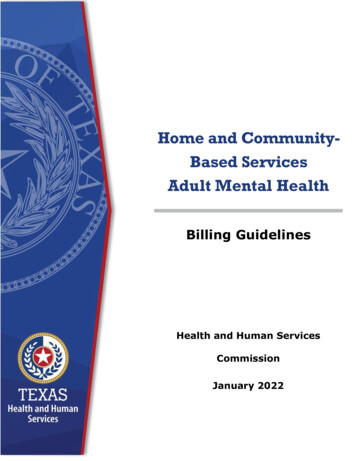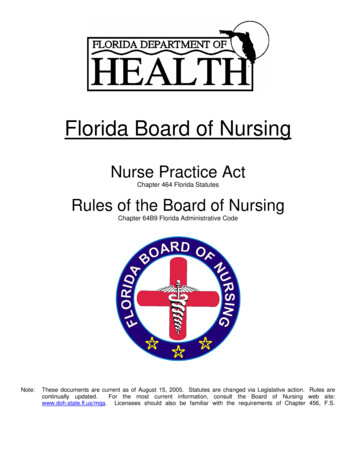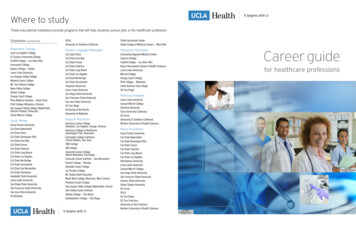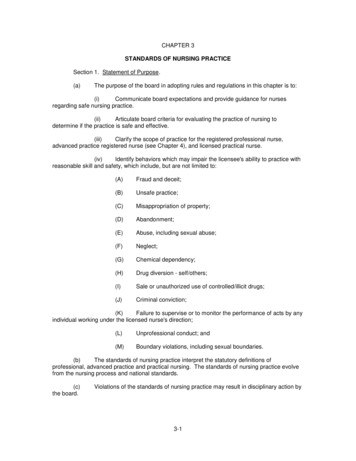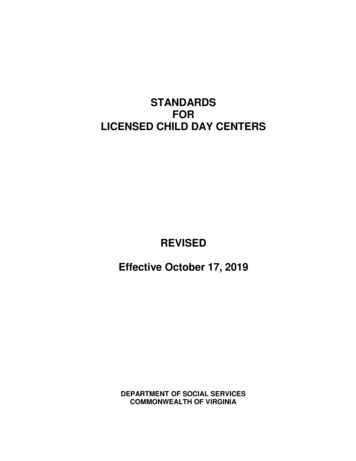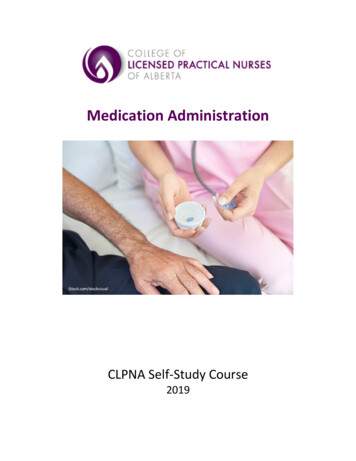
Transcription
Medication AdministrationCLPNA Self-Study Course2019
Legal and CopyrightThese modules are intended to support the continuing education of Alberta’s Licensed Practical Nurses.This course is a refresher and is not a substitute for proper accreditation or training. Always follow youremployer’s proper policies and procedures. College of Licensed Practical Nurses of Alberta 2018 - 2019Published by:College of Licensed Practical Nurses of Alberta (CLPNA)St. Alberta Trail Place 13163 – 146 Street NWEdmonton, Alberta, Canada T5L 4S8Phone: 780-484-8886Website: www.clpna.comEmail: profdev@clpna.comAcknowledgementsThe development of this resource guide is an initiative of the College of Licensed Practical Nurses ofAlberta (CLPNA). Production of this professional development initiative has been made possible througha grant from Alberta Labour, Foreign Qualification Recognition branch.Content Development and ReviewDr. John Collins has attained broad experience in the fields of nursing and education. He has worked as anRN and an RPN in clinical practice, administration, research, and education. As an individual who hascompleted undergraduate, graduate, and postgraduate studies, John values the principle of lifelong learningand encourages others to follow this path with a view to providing excellence in client care.Heather Buzila, who completed the editing of these course modules, has broad editorial experience thatincludes educational materials as well as fiction and nonfiction manuscripts.Design and ProgrammingRussell Sawchuk of Steppingstones Partnership, Inc., and Learning Nurse Resources Network completed thedesign and programing for this course.
Table of ContentsCourse Introduction . 1Purpose . 1Course Content . 1Strategies for Effective Learning . 1Module 1: Authorization for Medication Administration . 2Introduction . 2Learning Outcomes . 2Legislative Authority – Federal and Provincial . 2LPN Profession-Specific Documents . 6The LPN’s Role in Medication Management . 6Decision-Making for Safe Medication Management . 6Concluding Thoughts . 8Module 2: Pharmacology . 9Introduction . 9Learning Outcomes . 9Drug Sources . 9Drug Names . 9Pharmacology . 10Drug Classifications . 10Pharmacodynamics . 10Pharmacokinetics . 11Adverse Reactions . 13Concluding Thoughts . 13Module 3: Medication Management . 14Introduction . 14Learning Outcomes . 14Person-Centered Care . 14Medication Orders . 16Medication Reconciliation . 23Medication Preparation and Administration . 23Administration and Management of Controlled Drugs and Substances . 27Evaluating Client Outcomes . 33Client’s Own Medication . 34Supervision and Assignment of Components of Medication to Health Care Aides . 34Supervising a Practical Nurse Student Assigned to Perform a Restricted Activity . 35Concluding Thoughts . 36
Table of ContentsModule 4: Safety Considerations . 37Introduction . 37Learning Outcomes . 37Medication Safety . 37Storage, Disposal, and Transportation of Medication . 39Strategies to Reduce Medication Errors and Adverse Events . 40Concluding Thoughts . 41Glossary . 42Resources . 44Endnotes . 45References . 50
Course IntroductionPurposeThe College of Licensed Practical Nurses ofAlberta (CLPNA) has a mandate to ensurelicensed practical nurse (LPN) services inAlberta are provided in a manner that protectsand serves the public through excellence inpractical nursing. As regulated nursingprofessionals, LPNs have key roles in medicationadministration. These roles include assessmentand monitoring of clients, safe medicationadministration, and continuous evaluation anddocumentation of clients’ responses tomedication. Medication administration alsoincludes identifying risks and precautions andbeing able to respond to adverse eventsappropriately and in a timely manner. Thepurpose of this self-study course is to provideLPNs practicing in Alberta with a review ofpharmacology, the role of medicationmanagement, and the various components ofmedication administration.As members of the College of Licensed PracticalNurses of Alberta (CLPNA), LPNs’ authorization toengage in medication administration is governedby provincial and federal legislation, theGovernment Organization Act, 1 and the LicensedPractical Nurses Profession Regulation, 2 createdunder the Health Professions Act. In addition, theStandards of Practice for Licensed Practical Nursesin Canada 3 and Code of Ethics for LicensedPractical Nurses in Canada, 4 the CLPNA PracticeGuideline: Medication Management, 5 and thepolicies of the employment agency define thelegal and professional expectations of LPNs’ rolesin medication administration. For the purpose ofthis course, medication is defined as follows:A medication is a substance used inthe prevention, diagnosis, relief,treatment or cure of healthalterations No matter where[clients] receive their healthcare nurses play an essential role inpreparing and administeringmedications, teaching [clients] aboutmedications, and evaluating [clients’]responses to medications. 6†The terms drug(s) and medication(s) will be usedinterchangeably throughout this document.All bolded terms are defined in the glossary located atthe end of this course. All purple italicized text isquoted directly from CLPNA Practice Guideline:Medication Management.Course ContentThis course consists of four modules. Aftercompleting this course, learners will have examined authorization within legislation,regulation, and scope of practice for safemedication administration; listed the sources of drugs, their threedifferent names, and their classifications; defined the framework of pharmacologyincluding the pharmacokinetics andpharmacodynamics of medications; assessed their understanding of personcentred care in medicationadministration; and reviewed safe practices of handling,storage, and disposal of medications.Strategies of Effective LearningThere are different strategies for increasingknowledge, skills, and critical thinking inmedication administration. As medicationadministration is a comprehensive area of nursingpractice, this course is a broad source ofinformation. Do not try to complete all the coursematerial in one sitting. Individuals learn betterand remember more if they pace themselves. Thisself-study course is available at any time and atany location with an internet connection. Be sureto complete the quizzes included on the courseweb page.Finally, there are always opportunities forimproving your medication administrationpractice. Review the materials related to areasyou are having difficulty with or where you feelyou could advance your knowledge and nursingskills. Options for further study are included inthis course. In addition, see CLPNA’s website forcontinuing education providers.CLPNA Medications Administration – Page 1
Module 1: Authorization for Medication AdministrationIntroductionAsmembers of a regulated health careprofession, LPNs have a responsibility tounderstand and recognize the importance ofapplicable legislation and regulation in medicationadministration. This module examines thelegislative authority and the standards expectedof LPNs. LPNs are required to have theknowledge, skills, abilities, and competence toadminister medications.Learning OutcomesAt the end of this module you will be able to state the legislation and regulation thatinforms LPN practice in medicationadministration; identify the provincial and federal drugschedules and their relevance for safemedication administration; review the Standards of Practice and Codeof Ethics for licensed practical nurses inCanada; review CLPNA’s Medication ManagementPractice Guideline; identify the purpose of the CompetencyProfile for LPNs, specifically related tomedication management; and describe the factors for decision-makingthat include the client, the nurse, and theenvironment.Legislative Authority—Federaland ProvincialLPNs in Alberta are required to comply with bothprovincial and federal legislation and regulationsin medication administration. In addition, LPNsare expected to follow employers’ policies andprocedures in medication preparation,administration, evaluation, and documentation.As professional nurses, LPNs are bound by theStandards of Practice, the Code of Ethics, and theCompetency Profile for LPNs. 7 Through thesesupporting documents, LPNs have theresponsibility and accountability for autonomousnursing practice to provide the public, theemployer, and the profession with safe,competent, and ethical care.LPNs’ authorization to administer medication inAlberta is primarily governed by two pieces ofprovincial legislation, the GovernmentOrganization Act and the LPN ProfessionRegulation.The Government Organization Act 8 and theLicensed Practical Nurses Profession Regulation 9define the roles and responsibilities of LPNs in thedelivery of medications. Schedule 7.1 of theGovernment Organization Act contains a list ofhigh-risk health service activities, known asrestricted activities. These activities may only beperformed by regulated health professionals whohave been specifically authorized in theirprofession’s regulation to do so. This requirementensures that only professions with the necessarycompetencies can perform the restricted activitiesdefined in the Government Organization Act.Although medication administration is not aspecific restricted activity, the route or way amedication is administered may be a restrictedactivity. The Government Organization Act doesnot place restrictions on the administration ofmedications by non-invasive routes, which includeoral, topical, or inhalation.Section 13 of the LPN Profession Regulationpermits LPNs to perform the restricted activity ofadministering anything by an invasive procedureon body tissue below the dermis for specificpurposes. Therefore, under the LPN ProfessionRegulation, the LPN may prepare, initiate,monitor, titrate, and discontinue the delivery ofmedications that include, but are not limited to,the following routes: intravenous and injection viaintradermal, intramuscular, and subcutaneousroutes.CLPNA Medications Administration – Page 2
The exceptions to this broad authorization(outlined below) include administration ofmedication for the purposes of medicalassistance in dying and administeringmedications for the purpose of performing renaldialysis and immunization.NOTE: Please refer to the Competency Profile forLPNs regarding the LPN scope of practice specificto medication administration.Medical Assistance in Dying (MAID)In June 2016 the federal government enactedlegislation that allows for the provision of medicalassistance in dying under certain circumstances. InCanada, the Criminal Code allows nurses to assist aphysician or nurse practitioner (NP) in theprovision of MAID as per the direction of theirrespective regulatory bodies. A nurse who isassisting a physician or NP must also be under thedirection of the physician or NP, otherwise theycannot assist. Only a physician or NP can assesseligibility for MAID and only the physician or NPcan administer the substance(s) that causes death.It is essential for the LPN to understand that LPNswill have a limited role in MAID.The CLPNA recommends that: all LPNs review the Medical Assistance inDying: Guideline for Nurses in Albertadocument available on the CLPNA websiteto better understand the associatedrights, responsibilities and obligations;andany LPN who has been asked toparticipate in MAID contact a PracticeConsultant at CLPNA for advice.Renal Dialysis & ImmunizationIn accordance with the LPN Profession Regulation,the CLPNA considers Renal Dialysis andImmunization to be areas of Specialized Practice.In order for LPNs to provide immunizations orpractice dialysis nursing they must completeeducation approved by CLPNA and receiveauthorization from the CLPNA Registrar.LPNs can inform their nursing practice byunderstanding that drugs are regulated at bothfederal and provincial levels, with drugmanagement and responsibilities identified in thelegislation. The following describes legislation thatis relevant to LPN practice in Alberta.FederalDrugs in Canada are controlled at a federallevel by the Food and Drug Act, theControlled Drugs and Substances Act, and theregulations associated with those acts, includingNatural Health Products Regulations. HealthCanada is responsible for regulating food anddrugs to establish safety standards and qualitythrough Canada’s Food and Drug Act. 10 The Foodand Drug Act regulates the advertising, selling,and importing of foods, drugs, cosmetics, andmedical devices.The Controlled Drugs and Substances Act 11explains several drug-related offenses thatinclude exporting or importing, trafficking,growing, and possessing drugs. The act alsodefines activities related to prescriptionshopping—seeking prescriptions from multipledoctors and pharmacies for drug abuse—ascriminal activity. 12In Canada, drugs are categorized into threeschedules, or four categories: 131. Schedule 1 drugs require a prescription asa condition of sale.2. Schedule 2 drugs are available without aprescription but must be obtained from apharmacist.3. Schedule 3 drugs are available without aprescription from the self-selection areaof a pharmacy.4. Unscheduled drugs are not listed in anational or provincial schedule and maybe sold from any retail outlet.CLPNA Medications Administration – Page 3
The Province of Alberta, in conjunction with theNational Drug Scheduling Advisory Committee,decides how drugs are scheduled (Scheduled DrugRegulation) through an online database of thenational drug schedules. 15 The regulationorganizes drugs into categories according to thelevel of risk of taking medications with or withoutthe advice of a health care professional. Forexample, higher-risk medications are placed inSchedule 1, and lower-risk medications are placedin Schedule 3. For information regarding theScheduled Drugs Regulation, see the Pharmacyand Drug Act: Scheduled Drugs Regulation. 16ProvincialThe Province of Alberta has establishedlegislation to govern the management ofmedications in the province. In 2000 thePharmacy and Drug Act was passed. Thislegislation serves to regulate the delivery ofpharmacy services to maintain the integrity of thedrug distribution system and ensure thatpharmacy services are provided safely, effectively,and with accountability. 14Alberta’s provincial drug schedules are generallyaligned with the national drug schedules. To viewa list of exceptions, visit the Alberta College ofPharmacists’ website ’s drug schedules, with some examples,are provided in Table 1.CLPNA Medications Administration – Page 4
Table 1. Alberta’s Drug SchedulesAlberta’s Drug Schedules 17Schedule 1Schedule 2The drugs included in Schedule 1require a prescription as a condition ofsale and must be stored and sold onlyin the dispensary in a pharmacy. Drugsin this schedule include all federallyscheduled drugs and certain others,some of which are specific to Alberta.The latter may appear to be nonprescription drugs (as there will be nosymbol directly on the drug productlabel). Pharmacists must be aware ofthese products to prevent possiblesale without a prescription.Drugs listed in Schedule 1 of theScheduled Drugs Regulation aresubject to all the same considerationsas drugs listed in the Prescription DrugList of the Food and Drug Regulations(Canada).The standards of practice that apply todrugs in this schedule are the samestandards that apply to all prescriptionmedications.The drugs listed in Schedule 2 donot require a prescription as acondition of sale. These drugsmay be sold only from a licensedpharmacy or an institutionpharmacy by a pharmacist orunder the direct supervision of apharmacist. Schedule 2 drugsmust be stored and sold only inthe dispensary. Standards ofpractice for assessment oftherapy (standards 3 and 4), clientcounselling (standard 8), anddocumentation (standard 18)apply to Schedule 2 drugs.Examples in Schedule 1 includeamlodipine, Altace, citalopram,Lipitor, metoprolol, penicillin, andTylenol #3Examples in Schedule 2 includesilver nitrate, Gravol, Tylenol #1,codeine, nitroglycerin, andiron 30 mg.Schedule 3The drugs listed in Schedule 3 donot require a prescription as acondition of sale. These drugs maybe sold only from a licensedpharmacy or an institutionpharmacy. Schedule 3 drugs mustbe stored and sold only in theclient services area of thepharmacy. A pharmacist must takereasonable steps to aid a clientwho wishes to purchase aSchedule 3 drug (standard 9).Examples in Schedule 3 includefluoride and its salts, lactulose,acetaminophen in sustainedrelease formulations, and vaginalyeast infection products.Note: Unscheduled drugs not listed in Schedules 1, 2 or 3 (e.g., Tylenol, Bayer Aspirin, ibuprofen) may besold from any retail outlet. More examples are available in the full drug schedules, available from theNational Association of Pharmacy Regulatory Authorities (NAPRA). 18Over-the-Counter MedicationsOver-the-counter medications are Schedule 2, 3,and Unscheduled drugs outlined in the AlbertaPharmacy and Drug Act and the supportingScheduled Drugs Regulation. These medicationscan be acquired without a prescription.The LPN Profession Regulation does not authorizeLPNs to prescribe medications; having adiscussion with a client or family member andmaking recommendations about over-the-countermedications may be viewed as pseudoprescribing. Therefore, LPNs should advise theirclients to seek advice about over-the-countermedication from a health care professional who isauthorized to provide such information (e.g., anauthorized prescriber).In the event a client has an existing order (e.g.,postoperative) for over-the-counter medicationfrom an authorized prescriber, the LPN maydiscuss and provide education on this over-thecounter medication and suggest that the client orCLPNA Medications Administration – Page 5
family pick some up to have on hand upondischarge, only if this advice is consistent with theorder in place. This advice would be consideredappropriate as there is a covering order from anauthorized prescriber in place. To provide thiseducation, the LPN needs to be aware of theclient’s specific health information andmedication history.LPN Profession-SpecificDocumentsInall aspects of medication administration,the LPN is expected to follow the Standardsof Practice, Code of Ethics, MedicationManagement Practice Guideline, and the mostcurrent Competency Profile for LPNs, wherecompetencies specific to medicationadministration are outlined.The Medication Management Practice Guideline isto provide guidance to LPNs by enhancing theunderstanding of LPNs’ roles and expectedpractices in medication management. Guidelinesare not intended to be exhaustive but are toprovide guidance in making informed decisions.The guideline is based on federal and provinciallegislation, the Standards of Practice and Code ofEthics adopted by the CLPNA, and theCompetency Profile for LPNs. It is also informed byAccreditation Canada’s Medication ManagementStandards, guidelines provided by the Institute forSafe Medication Practices and the CanadianPatient Safety Institute, and the work of othernurse regulators across Canada. 19The Competency Profile for LPNs, 3rd edition,broadly defines the legislated scope of practicefor LPNs in Alberta and competencies specific topharmacological principles of medicationadministration. 20 As autonomous nurses, LPNshave responsibility for their own nursing practicesand, depending on their individual knowledge,experience, and workplace settings, will havetheir own levels of proficiency in applicablecompetencies in medication administration.The LPN’s Role in MedicationManagementMedication administration must be performed inaccordance with legislation, regulatory standardsand policy documents, and employer policy. TheLPN may administer medication under thefollowing conditions: The LPN must have the education,knowledge, and competence to acceptand transcribe medication ordersaccording to best practice; The LPN must have the education,knowledge, and competence to safelyprepare, initiate, administer, monitor,titrate, and discontinue medications; The LPN must adhere to the core rightsand checks of medication administrationto ensure client safety; and The LPN’s decision to administermedications must always include theclient’s individual needs determinedthrough health assessment, the LPN’scompetence, and the availability ofsupports in the practice environment toensure safe medication administration.Decision-Making for SafeMedication ManagementMedication management is defined as clientcentred care that optimizes safe, effective,and appropriate drug therapy provided incollaboration with the client and their health careteam. 21It is important to consider a number of factors infull utilization of LPN competencies, including anassessment of the client, the nurse, and theenvironment. These factors are derived from theevidence informed Decision-Making Frameworkfor Quality Nursing Care, established by acollaborative working group of representativesfrom the Canadian Council for Practical NurseRegulators, the Canadian Nurses Association, andthe Registered Psychiatric Nurses of Canada. 22CLPNA Medications Administration – Page 6
The ClientThe LPN’s assessment of the client should begrounded in evidence-based data. This datainforms the LPN of the appropriateness of themedication for the client. Some of the assessmentfactors include, but are not limited to, the client’s continuity of care; and current and anticipated state of acuityand complexity of care needs, based onthe client’so age (infants, children, older adults);o previous medication history;o historical and anticipated response tocare; ando challenges and barriers.In some circumstances, information about theclient may not be readily available or attainable.For example, the client may not be able tocommunicate information to the nurse due toconfusion or cognitive impairment. In thissituation, family members can assist withidentification, or there may be a previous healthrecord available with a unique identifier. Inemergency situations, life-saving medications maybe provided, and the client’s identity should beobtained as soon as possible afterward. In themeantime, it is common practice to assign atemporary unique identifier to the client. 23Individual Competence of the NurseAs members of a regulated health profession,LPNs have the responsibility and accountabilityfor autonomous nursing practice. This means theLPN is responsible for his or her own level ofcompetence. Maintaining competence inmedication administration should be evaluatedannually. Nursing competency represents theintegrated knowledge, skills, behaviours,attitudes, critical thinking, inquiry, and clinicaljudgments required by LPNs to provide safe,competent, and ethical nursing care.The expected competencies of an LPN formedication management can be found in thecurrent Competency Profile for LPNs. LPNcompetencies specifically related to medicationmanagement include understanding of thepharmacokinetics and pharmacodynamicsassociated with medication administration,relative assessments, safe preparation andadministration of medications, monitoring andmanaging any adverse effect or reaction, teachingclients, and evaluating anddocumenting/communicating the client’sresponse to medication.The core importance with the administration ofany medication is that the LPN is knowledgeableabout the medication, safe recommended dosage,appropriate route, indications, contraindications,side effects, interactions, precautions, onset,duration, excretion, related-lab values,appropriate evaluation and documentation. 24The Environment (Employer Policies)While the CLPNA has the regulatoryauthority to define the scope of practicefor LPNs in Alberta, employer organizations definethe roles of LPNs specific to the practiceenvironment(s). This may vary depending on thespecific care requirements, care delivery model,and staff mix in the practice area. LPNs must workwithin the role articulated by employer jobdescription and policy.With respect to medication administration,legislation does not specify what medications canbe administered by which provider. This allowsflexibility for employers to determine whatmedications are appropriate for certain providersto administer based on client needs, providercompetencies, and the resources available in thatspecific care environment. LPNs must followemployer policy around the medicationsconsidered appropriate for them to administerwithin a given care environment. In certain areasof practice, employers may require LPNs to obtainsite-specific education before performing certainactivities within their facility.CLPNA Medications Administration – Page 7
There are several environmental factors for LPNsto consider, including legislation and regulations; employer policy and procedures; decision-making guidelines; care-delivery model; evidence-informed practice; leadership support; staff mix; orga
practice dialysis nursing they must complete education approved by CLPNA and receive authorization from the CLPNA Registrar. LPNs can inform their nursing practice by understanding that drugs are regulated at both federal and provincial levels, with drug manag
